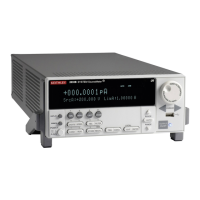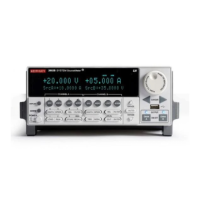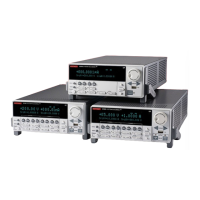2600AS-900-01 Rev. B / September 2008 Return to Section Topics A-5
Series 2600A System SourceMeter
®
Instruments User’s Manual Appendix A: Frequently Asked Questions
Polling for SRQs
To determine if the SourceMeter is the GPIB device that generated the SRQ, simply serial poll the
unit for the status byte, and test to see if the corresponding summary bit or bits are set. For
example, the following commands request the status byte and prints the result:
status_byte = status.condition
print(status_byte)
How do I store measurements in nonvolatile memory?
Each SMU has two dedicated reading buffers for measured readings, source values, and
timestamps: Buffer 1 (
nvbuffer1) and Buffer 2 (nvbuffer2). Reading buffers can be saved to
nonvolatile memory so that saved data will load automatically when power is cycled.
Front panel operation
See How do I use the reading buffer? for details on storing data from the front panel of the Series
2600A.
Remote programming
The following example demonstrates a typical way to use a reading buffer. The commands in the
following steps will perform three SMU A voltage measurements, store them in
nvbuffer1, and
then read the buffer:
Step 1: Clear and configure the buffer
The following command sequence will clear the buffer of all readings, and configure the buffer to
store timestamps and source values:
smua.nvbuffer1.clear()
smua.nvbuffer1.collecttimestamps = 1
smua.nvbuffer1.collectsourcevalues = 1
NOTE Setting collecttimestamps to 0 and collectsourcevalues to 0
will disable the storage of timestamps and source
values.
Step 2: Perform measurements
The following command sequence sets the measure count to three, turns on the output, performs
the three measurements, and then turns off the output:
smua.measure.count = 3
smua.source.output = smua.OUTPUT_ON
smua.measure.v(smua.nvbuffer1)
smua.source.output = smua.OUTPUT_OFF
The three measure readings, timestamps, and source values will be stored in the buffer.
Step 3: Read the buffer
The following code will output the three sets of data (nine values) in the same message:
rb1 = smua.nvbuffer1
printbuffer(1, rb1.n, rb1, rb1.timestamps, rb1.sourcevalues)

